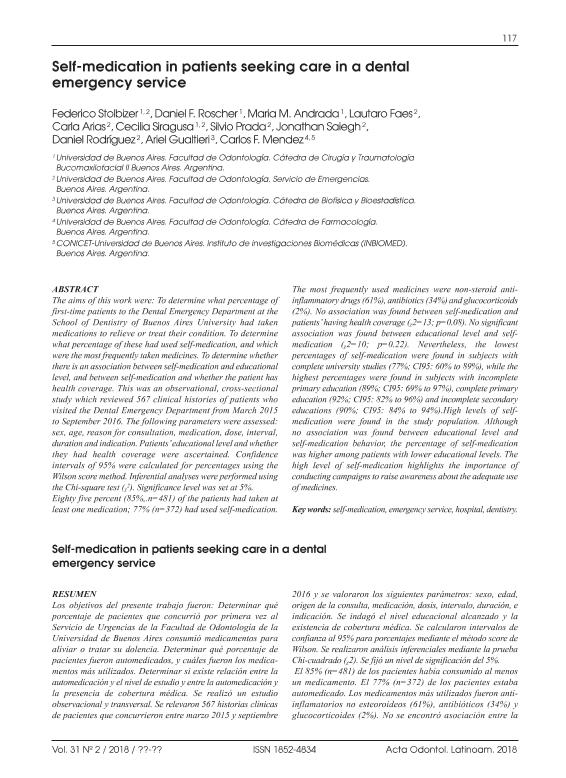Mostrar el registro sencillo del ítem
dc.contributor.author
Stolbizer, Federico
dc.contributor.author
Roscher, Daniel F.
dc.contributor.author
Andrada, Maria M.
dc.contributor.author
Faes, Lautaro
dc.contributor.author
Arias, Carla
dc.contributor.author
Siragusa, Cecilia
dc.contributor.author
Prada, Silvio
dc.contributor.author
Saiegh, Jonathan
dc.contributor.author
Rodriguez, Daniel
dc.contributor.author
Gualtieri, Ariel Félix

dc.contributor.author
Mendez, Carlos Fernando

dc.date.available
2019-10-22T19:23:56Z
dc.date.issued
2018-08
dc.identifier.citation
Stolbizer, Federico; Roscher, Daniel F.; Andrada, Maria M.; Faes, Lautaro; Arias, Carla; et al.; Self-medication in patients seeking care in a dental emergency service; ImageGraf; Acta Odontológica Latinoamericana; 31; 2; 8-2018; 117-121
dc.identifier.issn
0326-4815
dc.identifier.uri
http://hdl.handle.net/11336/86977
dc.description.abstract
The aims of this work were: To determine what percentage of firsttime patients to the Dental Emergency Department at the School of Dentistry of Buenos Aires University had taken medications to relieve or treat their condition. To determine what percentage of these had used selfmedication, and which were the most frequently taken medicines. To determine whether there is an association between selfmedication and educational level, and between selfmedication and whether the patient has health coverage. This was an observational, crosssectional study which reviewed 567 clinical histories of patients who visited the Dental Emergency Department from March 2015 to September 2016. The following parameters were assessed: sex, age, reason for consultation, medication, dose, interval, duration and indication. Patients' educational level and whether they had health coverage were ascertained. Confidence intervals of 95% were calculated for percentages using the Wilson score method. Inferential analyses were performed using the Chisquare test (ᵪ2). Significance level was set at 5%. Eighty five percent (85%,.n=481) of the patients had taken at least one medication; 77% (n=372) had used selfmedication. The most frequently used medicines were nonsteroid antiinflammatory drugs (61%), antibiotics (34%) and glucocorticoids (2%). No association was found between selfmedication and patients' having health coverage (ᵪ2=13; p=0.08). No significant association was found between educational level and selfmedication (ᵪ2=10; p=0.22). Nevertheless, the lowest percentages of selfmedication were found in subjects with complete university studies (77%; CI95: 60% to 89%), while the highest percentages were found in subjects with incomplete primary education (89%; CI95: 69% to 97%), complete primary education (92%; CI95: 82% to 96%) and incomplete secondary educations (90%; CI95: 84% to 94%).High levels of selfmedication were found in the study population. Although no association was found between educational level and selfmedication behavior, the percentage of selfmedication was higher among patients with lower educational levels. The high level of selfmedication highlights the importance of conducting campaigns to raise awareness about the adequate use of medicines.
dc.format
application/pdf
dc.language.iso
eng
dc.publisher
ImageGraf
dc.rights
info:eu-repo/semantics/openAccess
dc.rights.uri
https://creativecommons.org/licenses/by-nc-sa/2.5/ar/
dc.subject
SELF-MEDICATION
dc.subject
DENTAL CARE
dc.subject
EMERGENCY SERVICE
dc.subject.classification
Ciencias y Servicios de Cuidado de la Salud

dc.subject.classification
Ciencias de la Salud

dc.subject.classification
CIENCIAS MÉDICAS Y DE LA SALUD

dc.title
Self-medication in patients seeking care in a dental emergency service
dc.type
info:eu-repo/semantics/article
dc.type
info:ar-repo/semantics/artículo
dc.type
info:eu-repo/semantics/publishedVersion
dc.date.updated
2019-10-15T19:39:58Z
dc.identifier.eissn
1852-4834
dc.journal.volume
31
dc.journal.number
2
dc.journal.pagination
117-121
dc.journal.pais
Argentina

dc.journal.ciudad
Buenos Aires
dc.description.fil
Fil: Stolbizer, Federico. Universidad de Buenos Aires. Facultad de Odontología; Argentina
dc.description.fil
Fil: Roscher, Daniel F.. Universidad de Buenos Aires. Facultad de Odontología; Argentina
dc.description.fil
Fil: Andrada, Maria M.. Universidad de Buenos Aires. Facultad de Odontología; Argentina
dc.description.fil
Fil: Faes, Lautaro. Universidad de Buenos Aires. Facultad de Odontología; Argentina
dc.description.fil
Fil: Arias, Carla. Universidad de Buenos Aires. Facultad de Odontología; Argentina
dc.description.fil
Fil: Siragusa, Cecilia. Universidad de Buenos Aires. Facultad de Odontología; Argentina
dc.description.fil
Fil: Prada, Silvio. Universidad de Buenos Aires. Facultad de Odontología; Argentina
dc.description.fil
Fil: Saiegh, Jonathan. Universidad de Buenos Aires. Facultad de Odontología; Argentina
dc.description.fil
Fil: Rodriguez, Daniel. Universidad de Buenos Aires. Facultad de Odontología; Argentina
dc.description.fil
Fil: Gualtieri, Ariel Félix. Universidad de Buenos Aires. Facultad de Odontología; Argentina
dc.description.fil
Fil: Mendez, Carlos Fernando. Universidad de Buenos Aires. Facultad de Odontología. Cátedra de Farmacología; Argentina. Consejo Nacional de Investigaciones Científicas y Técnicas. Oficina de Coordinación Administrativa Houssay. Instituto de Investigaciones Biomédicas. Universidad de Buenos Aires. Facultad de Medicina. Instituto de Investigaciones Biomédicas; Argentina
dc.journal.title
Acta Odontológica Latinoamericana

dc.relation.alternativeid
info:eu-repo/semantics/altIdentifier/url/http://actaodontologicalat.com/vol-31-%c2%b7-no-2-%c2%b7-october-2018/
Archivos asociados
